Extended thru July 15
“A Cut Above: 12 Paper Masters”Christopher Henry Gallery, 127 Elizabeth St., NYC“The Christopher Henry Gallery’s current exhibition, A Cut Above: 12 Paper Masters, gives a whole new meaning to the term “paper cut.” Paying homage to a dozen artists who use razor-sharp blades as their central tool, this Diana Ewer-curated showcase celebrates not only a growing trend, but also the delicate craftsmanship of each talent behind the fragile works on view.” - ARTLOGAmateurs look for inspiration; the rest of us just get up and go to work. Chuck Close
Monday, July 30, 2012
Friday, July 27, 2012
Shea Hembrey: How I became 100 artists

By SARA CORBETT
You could be forgiven for not knowing about the artist Mart Meyer, who lives in Dallas and photographs what he sees almost moment by moment. Or for not having heard of the Chinese artist Ju Hu, who created a large-scale work examining the “malleable flow of time” as he camped out in an autumnal forest and tried to tape every fallen leaf back onto its tree. Almost certainly, you’re not acquainted with the art made by Rosalie Starr, who died in 1969 but whose sculptures were recently discovered in the attic of a Georgia boardinghouse, or the guerrilla feces paintings — quite beautiful, really — that have been popping up on the walls of public restrooms in New York and four other states and attributed to an artist known only as the East Coast Swiper.
Multimedia
Ryan Pfluger for The New York Times
Hembrey’s workroom in Frenchtown, N.J., where 100 artists were born. More Photos »
Ryan Pfluger for The New York Times
This is because the East Coast Swiper and Rosalie Starr and Mart Meyer and Ju Hu are just-barely discovered artists. Their work can, at the moment, be seen only inside a curious book — the 412-page catalog for an obscure and yet-to-be-mounted biennial exhibition called “Seek: 100 in 2011.”
The catalog displays an array of work from 100 quirky and previously unknown artists, each one introduced by a brief bit of text. The book’s glossy photographs show etchings, watercolor, mixed-media sculpture, room-size installations, still photographs taken from short films, self-portraits, grand abstract paintings, tiny carved objects and staggeringly detailed trompe l’oeils. There’s art made from acrylics, pastels and clay, not to mention saltine crackers, parachute fabric, butterflies, lichen and lead.
From a former prostitute named Nina Shaufner, there is an exquisite ink-and-chalk rendering of a man’s hairy buttocks. (“Her series of Johns Drawings are a cathartic confession of her past and a thorough attempt to reclaim power by objectifying these very clients.”) Another set of photos shows a collection of painted borderlines and talismanic, glittering salt piles created by a sleepwalking housewife from Memphis. (“Audrey is always startled by these actions, but clearly understands them as protective creations meant to shield her family from any harm.”)
According to an introduction written by two curators named Calinda Salazar and Fletcher Ramsey, the biennial exhibition has been designed to showcase “unexposed artists, hidden practices, folk traditions and mystics.”
What at first seems most striking about “Seek” is that it’s both odd and big. The artwork could fill several marble-floored pavilion halls in Venice or at the Whitney. What’s most surprising, however, is the book’s final revelation — a brief note offered on the last page — that there aren’t, as it turns out, 100 artists. Nor are there two curators. The biennial catalog is itself a sort of meta-piece of art, and the artists represented are really only one artist — a guy who has chosen to bifurcate and fracture and channel himself in a hundred different ways. Every work in the book, in other words, was conceived of and handmade by a single person — a 37-year-old named Shea Hembrey — over a two-year period, in a mad and, he would tell you, somewhat desperate attempt to answer his own questions about what makes art meaningful.
Shea Hembrey is tall and lanky with a wispy beard and dark hair that flops boyishly to either side of his face. He was born and reared in rural Arkansas, but these days he lives in the hamlet of Frenchtown, N. J., in the second-story apartment of a well-kept Victorian cottage on a street filled with the same. For an artist, it’s a pretty nice life. The town is quaint and friendly. People greet him on the street by name. When he is feeling pensive, he goes for long, solitary runs on a dirt pathway that follows the flat rush of the nearby Delaware River. Out behind the house there is a drafty barn, which he uses for a studio.
Before I went to meet him for the first time, Hembrey explained his project on the phone, saying that he’d made all the work in the biennial — some 400 pieces of art, rendered in 100 different styles — in just under two years. Arriving in Frenchtown, I’d done the math: Hembrey invented his pretend artists and their back stories, bought their materials and created their work at roughly four finished pieces per week. It meant there had been no time for a break, or slowdown, or even, it would seem, for a leisurely afternoon of artsy brooding. Given that many artists spend years or even decades mining a single theme or technique, what Hembrey had done, creatively speaking, seemed the equivalent of running a marathon at a sprinter’s pace.
When I showed up at his house on an unusually warm day last winter, Hembrey was lying on a long wooden bench on the front porch, his stovepipe legs hooked over an armrest, looking nothing like the fiendish worker I’d imagined. He spent the morning color-correcting a printer’s proof of the biennial catalog, which he was soon to self-publish and sell on his Web site.
Hembrey is a gentle presence. He speaks in a soft Southern drawl and tells looping stories involving things like tornadoes, all-terrain vehicles and wandering armadillos, mostly originating in his hometown, Hickory Grove, Ark., which at last count had a population of 129. He will, when the moment calls for it, shout a thoroughly unironic “Go-llleee!” His mother is a hairdresser, his sister an Army wife and his father recently retired after a long career as a factory worker. Hembrey, who has two master’s degrees in studio art and keeps his toenails painted a glimmering shade of silver, can seem both folksy and ethereal at the same time.
His Frenchtown apartment resembles a four-room curio cabinet, filled with antiques and other oddities he’s found over years of flea-market browsing, travel and ferocious bidding on eBay. He has collections of Indonesian shadow puppets, hollowed birds’ eggs and African lip ornaments. Showing me around, he dropped one small object after another into my palm — an antique Indian coin the size of a sesame seed, an exotic feather, a prehistoric gizzard stone. “Isn’t this amazing?” he’d say. “Now, doesn’t that just give you goose bumps?”
Like many other artists, Hembrey lives on the outskirts of the New York-centered art establishment, which can be famously indifferent, cyclically anointing and inflating its stars while leaving the rest to languish. Over the years, he’s had steady but modest success, selling paintings in small galleries and to private buyers. Insofar as any artistic career relies on a mix of good fortune and long-term resilience, Hembrey has managed both. He has spent the last decade or so “cobbling a life” — making art while moving between seasonal jobs, artist residencies and house-sitting gigs.
For the last several years, he has lived cheaply in Frenchtown, courtesy of its most famous resident, the writer Elizabeth Gilbert. The two met at a Wyoming artist colony in October 2004. Gilbert, who at the time was a respected but relatively obscure writer, was working on an early draft of “Eat, Pray, Love.” Hembrey was making a series of detailed paintings of sticks and strings and folk healer’s charms, images from the life of his grandfather, who used to cure warts with whittled matchsticks in the parking lot of the Arkansas aluminum factory where he worked.
Gilbert and Hembrey became friends. That Halloween, they went trick-or-treating dressed as first ladies — she as Barbara Bush; he as Jacqueline Kennedy. When Gilbert visited his family’s farm, Hembrey introduced her to Arkansas “yard-sledding,” dragging her at high speed on a piece of plywood roped behind his A.T.V. Then Hembrey went off to art school at Cornell. The publication of “Eat, Pray, Love” catapulted Gilbert into literary stardom and surprise wealth. After Hembrey finished his degree, Gilbert persuaded him to move to New Jersey, offering him a job working three days a week in the Asian-import store she started with her husband, José Nunes.
Gilbert, who lives on a hillside not far from Hembrey, has made a sport of lobbying friends to relocate to Frenchtown. She can cite, with the zeal of a Chamber of Commerce staffer, the town’s many charms and lifestyle advantages. Her overtures frequently seem to include some form of housing: to help lure a dancer friend from Indiana, she built a dance studio next to the import shop. She bought the house with the barn expressly for Hembrey, allowing him to live rent-free while he worked on the biennial. She also has a second house — a renovated church in nearby Milford — that she lends out to a fellow writer. Around town, Gilbert is a munificent, chatty presence. She hugs the waitresses at a local restaurant and talks to more or less every person sitting at the bar. In 2008 she started her own curbside food-donation program on behalf of Frenchtown’s food bank, and her steady stream of “Eat, Pray, Love” tourists helps fill the rooms at the local B. & B.’s.
Hembrey, for his part, was a high-value freeloader. He mowed the lawn, kept things fastidiously neat and fixed whatever broke. In Gilbert’s most recent book, he is credited in her acknowledgments for listening to “hours and hours and hours” of her thoughts. Over time, Gilbert’s friendship with Hembrey took on a more straightforward element of patronage. About a year into his work on the Seek biennial, she and Nunes stopped requiring him to show up for the job at their shop but continued to pay him a small salary until he completed the project last winter. “It felt like the right thing to do,” Gilbert says. “We were wasting his time, making him sell Buddhas and jewelry.”
The imaginary biennial, Hembrey told me, began as a sort of dare to himself, made during a trip to Europe in 2007, after he finished his degree at Cornell. Seeking inspiration and using his sister’s home on an Army base in Germany as his launching pad, Hembrey visited as many major recurring exhibitions as he could. He went to the sprawling contemporary art show Documenta and the Münster Sculpture Project, both in Germany, as well as to the Venice Biennale. In Switzerland, he saw Art Basel, a vast fair that draws influential gallerists and deep-pocketed buyers. His primary response to what he saw — what was billed as the most exciting and valued art being made in the world — was disappointment. “I wanted to love the art I’d seen,” he says now. “But so much of it just felt indulgent.”
He describes what struck him — especially at Documenta, a roughly $20 million undertaking held every five years in Kassel — as poorly constructed, deliberately controversial work, paired with artist statements that threw around fuzzy, self-important words like “diaspora” and “postmodern.” It felt, he says, “like a big charade.” (Critics by and large agreed. Holland Cotter, writing in The Times, called that year’s Documenta “almost perversely esoteric.” The London Telegraph deemed it “the worst art show ever.”)
Hembrey says he left the European exhibitions feeling confused. “I just kept thinking to myself, What is it I am hoping to see?”
The Seek Biennial became his answer. “At first, I thought I’d do an international show of real people who haven’t been discovered, who understand art but are outside the establishment — the mystics and oddball characters,” he says. “But then I kept thinking, How the hell will I find them? How will I ever fund this?” This was followed by an idea that somehow, at the time, seemed more sensible: “I thought: Well, what if I just make the art myself? What if the biennial became the work of art?”
Keeping track of his ideas on a piece of notebook paper, folded many times and often stashed in his back pocket, Hembrey developed a list of artists and potential projects, along with a loose schedule. “Do 7 by April,” reads one margin note. “Finish and get to 40!” says another.
Hembrey describes the rapid-fire art-making and stylistic shape-shifting required for the biennial as a grueling purification ritual. Often, he says, he first imagined an artist and then invented the art. Sometimes it was the other way around. He worked late into the night, usually seven days a week. Occasionally he tapped people he knew to serve as models for photographs, especially family members who were more likely to abide by his policy of offering no context for the project at hand. Which is how he got his parents to put on their best clothes and dance on a grave site near his hometown (on behalf of Micah Abernathy and Bud Holland, the artists behind the “dig jig,” a “joyous practice linked with death”). Friends, too, were tapped to pose in things like gas masks and prairie dresses and sometimes elaborate, contraption-like clothing Hembrey built but refused to explain.
“It was all very secretive,” says Elisabeth Haly Meyer, an artist who taught Hembrey at Cornell. “I couldn’t imagine, honestly, what he was doing.”
Hembrey talks about his artists — and he says it that way, “my artists” — as fully realized people, using the same vaguely custodial tone that novelists sometimes employ when discussing their characters. Roy Penix, an Appalachian artist (and Hembrey creation) who makes personalized sculptures to hold cremated ashes, is, for example, “a really nice good guy.” Ed Fortune, on the other hand, a charismatic (and entirely made-up) performance artist who started a fake cult and whose edited Bibles and half-built church are photographed in the Seek catalog, makes his creator “a little uncomfortable.”
“I let them live there in my head,” he says. “I could talk to them if I needed to. I knew them well enough not to have to stop and ask questions, like ‘Would this person think this way? Does he believe this?’ ”
Some of the work in Hembrey’s Seek catalog is intentionally amateurish. Some of it is plainly funny. One of his artists is a 10-year-old boy who paints owls on his family’s furniture. There’s also a pair of bored, retired executives who’ve taken to spray-painting images of martini glasses, graffiti-style, around their Southern California suburb. Lodged inside this is a sort of protest: Hembrey speaks of the biennial as an attempt to widen the boundaries of the “art world.” With it, he offers a whimsical if ultimately unrealistic alternative to the highly networked grid of Chelsea — a place where oddballs and everyday folks are recognized for making good art.
If Hembrey is critiquing the art world, his is not an especially defiant takedown, in part because the biennial is an illusion; his everyday folks aren’t real but rather spring from the imagination of a trained artist with the time and resources to create. Hembrey calls it “satire with reverence,” insisting he is not savaging the art world so much as having fun with the notion of who and what deserve inclusion. “For me, art is make-believe,” he says. “It’s enchantment. It’s a fable. I’m enjoying that and playing with it. Of course it’s serious, and art is serious, but I’m not going to rarefy it.”
His made-up biennial joins a long tradition of art-world trickery that plays with ideas of artifice and hype. In the 1980s, a renegade fictional artist named John Dogg — later revealed to be the alter ego of the artist Richard Prince and the late art dealer Colin de Land — successfully displayed and sold work, his legend propelled by phony interviews. More recently, the New Haven-based artist Joe Scanlan created a pretend artist named Donelle Woolford, a young black woman with a growing body of actual work, hiring a series of actresses to play Woolford at her own openings. Much as Hembrey doesn’t entirely obscure his role in making the Seek biennial, Scanlan’s invention of Woolford is one he acknowledges, though quietly. “I like the idea that paintings are not representations of an artist’s psyche,” he told an interviewer last year. “Making the paintings is what gives the artist her psyche in the first place.”
In hand-making the work of 100 artists, Hembrey has also reversed — and indirectly skewered — the factory-like way art is sometimes produced. It’s one of the art world’s open secrets, dating back to Michelangelo: many giants in the field hire squads of studio assistants to execute their ideas. Jeff Koons has said he employs about 120 studio assistants. Damien Hirst reportedly uses as many as 100. “I don’t understand it,” Hembrey says. “I think that an artist should be a skilled craftsman.”
Hembrey likes to say that his upbringing on 80 acres of sorghum fields gave him both his work ethic and his creative versatility. When you live on a dirt road 150 miles from the nearest city, he points out, improvisation becomes a necessity — and also, in some ways, a utilitarian form of art. Old tires are repurposed as hinges for the barn door. Scrap wood is fashioned into shelves. “Where I grew up,” he says, “there was a mysticism and creativity to everything. Everyone made things with their hands.”
The Seek biennial may well be viewed as a stunt, as a bid for attention from someone who has yet to catch the eye of the industry’s kingmakers — an attempt to build, with a biennial, the very palace he hopes to enter. “It’s outsider art done with insider information,” says the critic Dave Hickey, who has seen the biennial catalog and says he is not much impressed with the quality of the art, labeling it “naïve postmodern” and overly self-conscious. The writer and curator Lawrence Weschler is more smitten, calling Hembrey’s biennial “delightful and delighting” and also “Socratic.” “It’s got a wonderful whiff of fraudulence,” he says. “You look at it and say: ‘Is this real? Is it not real? Is he making fun of me? ’ ”
Hembrey himself is as paradoxical as the work he has created. His down-home mannerisms and his focus on misfits are offset by the fact that he is well educated, well traveled and also, in part thanks to Gilbert, who has introduced him around, reasonably well connected. Whether he is an outsiderish insider, or an insiderish outsider, it’s hard to say. Either way, it puts him — and his biennial — among the curious crosscurrents of high and low culture, of belonging and not belonging.
In March, Hembrey spoke at the TED conference in California, spinning a few charming Arkansas stories and then clicking through slides of his imaginary artists’ work. He was given a standing ovation, though later caught flak from commenters on the TED Web site for advocating for a more-accessible art world while putting a $1,000 price tag on the hardcover limited-edition copies of his catalog. (In an online debate that grew heated, several commenters defended Hembrey’s price point: “Attend a Sotheby’s auction and see how many works of art you can purchase for a thousand dollars,” one wrote. “In fact, drop by any gallery and see what you can purchase for a thousand dollars.”) Hembrey declines to say how many copies have sold, but the debate over price illuminates a larger tension between art and the marketplace. He continues to fret over wanting the collection to be seen and not thought of as exclusive, but also wishing for it to be taken seriously and beyond that, needing to make a living.
Hembrey’s cluttered barn-studio now holds much of the Seek biennial. “Those are Rosalie Starr’s tar paintings,” he said one afternoon as we walked through it, pointing at several canvases propped against a wall. We passed part of a silk-lined coffin that once housed a cremains sculpture made by Roy Penix and a half-collapsed, ornamented homeless shelter made by a Minnesota artist named Dustbin Turner, whom the catalog quotes as saying, “Everyone deserves real art and should live around real art — not just the fat cats.”
This, in the end, is Hembrey’s message — and also his conundrum when it comes to spreading it. Without the recognition of some sort of art establishment, without the involvement of a serious fat cat or two, the art he has made will most likely remain sitting, partly dismantled, in the barn. His hope is eventually to mount a biennial-style exhibition that features the art and the biographies of his 100 creative stand-ins.
Walking up the creaky stairs leading to the barn’s loft that day, we came upon one of the biggest and more memorable pieces included in “Seek,” a 20-foot-long dangling white obelisk, made from thousands of pieces of blank paper and hung from the rafters, bulbous in the middle and then funneling to a thin point that delicately grazed the floor. This was Hembrey’s “pregnant tornado,” assiduously taped and sculptured over a number of hot summer days. He’d also covered most of the loft, stapling another 5,000 or so sheets of paper to the walls and vaulted ceilings. In the Seek catalog, the tornado is attributed to a London-based artist named Janice Price, who according to the text is trying to express the confused, exhilarating moment when a fresh idea is stirring — gathering heft and speed without quite taking form.
It seemed possible that the paper tornado might be a fair metaphor to describe the energetic blur of his art-making over those two years, and perhaps the dueling strength and fragility of any creative endeavor, the push and pull between art and the world it lives in.
I asked Hembrey whether he identified more strongly with Janice Price than with his other 99 artists. He thought about it a second, his eyes moving over the remnants of what he’d made. “I don’t know,” he said, shrugging lightly. “In the end I think I’m just really me.”
Sara Corbett is a contributing writer for the magazine.
Shea Hembrey: How I became 100 artists

By SARA CORBETT
You could be forgiven for not knowing about the artist Mart Meyer, who lives in Dallas and photographs what he sees almost moment by moment. Or for not having heard of the Chinese artist Ju Hu, who created a large-scale work examining the “malleable flow of time” as he camped out in an autumnal forest and tried to tape every fallen leaf back onto its tree. Almost certainly, you’re not acquainted with the art made by Rosalie Starr, who died in 1969 but whose sculptures were recently discovered in the attic of a Georgia boardinghouse, or the guerrilla feces paintings — quite beautiful, really — that have been popping up on the walls of public restrooms in New York and four other states and attributed to an artist known only as the East Coast Swiper.
Multimedia
Ryan Pfluger for The New York Times
Hembrey’s workroom in Frenchtown, N.J., where 100 artists were born. More Photos »
Ryan Pfluger for The New York Times
This is because the East Coast Swiper and Rosalie Starr and Mart Meyer and Ju Hu are just-barely discovered artists. Their work can, at the moment, be seen only inside a curious book — the 412-page catalog for an obscure and yet-to-be-mounted biennial exhibition called “Seek: 100 in 2011.”
The catalog displays an array of work from 100 quirky and previously unknown artists, each one introduced by a brief bit of text. The book’s glossy photographs show etchings, watercolor, mixed-media sculpture, room-size installations, still photographs taken from short films, self-portraits, grand abstract paintings, tiny carved objects and staggeringly detailed trompe l’oeils. There’s art made from acrylics, pastels and clay, not to mention saltine crackers, parachute fabric, butterflies, lichen and lead.
From a former prostitute named Nina Shaufner, there is an exquisite ink-and-chalk rendering of a man’s hairy buttocks. (“Her series of Johns Drawings are a cathartic confession of her past and a thorough attempt to reclaim power by objectifying these very clients.”) Another set of photos shows a collection of painted borderlines and talismanic, glittering salt piles created by a sleepwalking housewife from Memphis. (“Audrey is always startled by these actions, but clearly understands them as protective creations meant to shield her family from any harm.”)
According to an introduction written by two curators named Calinda Salazar and Fletcher Ramsey, the biennial exhibition has been designed to showcase “unexposed artists, hidden practices, folk traditions and mystics.”
What at first seems most striking about “Seek” is that it’s both odd and big. The artwork could fill several marble-floored pavilion halls in Venice or at the Whitney. What’s most surprising, however, is the book’s final revelation — a brief note offered on the last page — that there aren’t, as it turns out, 100 artists. Nor are there two curators. The biennial catalog is itself a sort of meta-piece of art, and the artists represented are really only one artist — a guy who has chosen to bifurcate and fracture and channel himself in a hundred different ways. Every work in the book, in other words, was conceived of and handmade by a single person — a 37-year-old named Shea Hembrey — over a two-year period, in a mad and, he would tell you, somewhat desperate attempt to answer his own questions about what makes art meaningful.
Shea Hembrey is tall and lanky with a wispy beard and dark hair that flops boyishly to either side of his face. He was born and reared in rural Arkansas, but these days he lives in the hamlet of Frenchtown, N. J., in the second-story apartment of a well-kept Victorian cottage on a street filled with the same. For an artist, it’s a pretty nice life. The town is quaint and friendly. People greet him on the street by name. When he is feeling pensive, he goes for long, solitary runs on a dirt pathway that follows the flat rush of the nearby Delaware River. Out behind the house there is a drafty barn, which he uses for a studio.
Before I went to meet him for the first time, Hembrey explained his project on the phone, saying that he’d made all the work in the biennial — some 400 pieces of art, rendered in 100 different styles — in just under two years. Arriving in Frenchtown, I’d done the math: Hembrey invented his pretend artists and their back stories, bought their materials and created their work at roughly four finished pieces per week. It meant there had been no time for a break, or slowdown, or even, it would seem, for a leisurely afternoon of artsy brooding. Given that many artists spend years or even decades mining a single theme or technique, what Hembrey had done, creatively speaking, seemed the equivalent of running a marathon at a sprinter’s pace.
When I showed up at his house on an unusually warm day last winter, Hembrey was lying on a long wooden bench on the front porch, his stovepipe legs hooked over an armrest, looking nothing like the fiendish worker I’d imagined. He spent the morning color-correcting a printer’s proof of the biennial catalog, which he was soon to self-publish and sell on his Web site.
Hembrey is a gentle presence. He speaks in a soft Southern drawl and tells looping stories involving things like tornadoes, all-terrain vehicles and wandering armadillos, mostly originating in his hometown, Hickory Grove, Ark., which at last count had a population of 129. He will, when the moment calls for it, shout a thoroughly unironic “Go-llleee!” His mother is a hairdresser, his sister an Army wife and his father recently retired after a long career as a factory worker. Hembrey, who has two master’s degrees in studio art and keeps his toenails painted a glimmering shade of silver, can seem both folksy and ethereal at the same time.
His Frenchtown apartment resembles a four-room curio cabinet, filled with antiques and other oddities he’s found over years of flea-market browsing, travel and ferocious bidding on eBay. He has collections of Indonesian shadow puppets, hollowed birds’ eggs and African lip ornaments. Showing me around, he dropped one small object after another into my palm — an antique Indian coin the size of a sesame seed, an exotic feather, a prehistoric gizzard stone. “Isn’t this amazing?” he’d say. “Now, doesn’t that just give you goose bumps?”
Like many other artists, Hembrey lives on the outskirts of the New York-centered art establishment, which can be famously indifferent, cyclically anointing and inflating its stars while leaving the rest to languish. Over the years, he’s had steady but modest success, selling paintings in small galleries and to private buyers. Insofar as any artistic career relies on a mix of good fortune and long-term resilience, Hembrey has managed both. He has spent the last decade or so “cobbling a life” — making art while moving between seasonal jobs, artist residencies and house-sitting gigs.
For the last several years, he has lived cheaply in Frenchtown, courtesy of its most famous resident, the writer Elizabeth Gilbert. The two met at a Wyoming artist colony in October 2004. Gilbert, who at the time was a respected but relatively obscure writer, was working on an early draft of “Eat, Pray, Love.” Hembrey was making a series of detailed paintings of sticks and strings and folk healer’s charms, images from the life of his grandfather, who used to cure warts with whittled matchsticks in the parking lot of the Arkansas aluminum factory where he worked.
Gilbert and Hembrey became friends. That Halloween, they went trick-or-treating dressed as first ladies — she as Barbara Bush; he as Jacqueline Kennedy. When Gilbert visited his family’s farm, Hembrey introduced her to Arkansas “yard-sledding,” dragging her at high speed on a piece of plywood roped behind his A.T.V. Then Hembrey went off to art school at Cornell. The publication of “Eat, Pray, Love” catapulted Gilbert into literary stardom and surprise wealth. After Hembrey finished his degree, Gilbert persuaded him to move to New Jersey, offering him a job working three days a week in the Asian-import store she started with her husband, José Nunes.
Gilbert, who lives on a hillside not far from Hembrey, has made a sport of lobbying friends to relocate to Frenchtown. She can cite, with the zeal of a Chamber of Commerce staffer, the town’s many charms and lifestyle advantages. Her overtures frequently seem to include some form of housing: to help lure a dancer friend from Indiana, she built a dance studio next to the import shop. She bought the house with the barn expressly for Hembrey, allowing him to live rent-free while he worked on the biennial. She also has a second house — a renovated church in nearby Milford — that she lends out to a fellow writer. Around town, Gilbert is a munificent, chatty presence. She hugs the waitresses at a local restaurant and talks to more or less every person sitting at the bar. In 2008 she started her own curbside food-donation program on behalf of Frenchtown’s food bank, and her steady stream of “Eat, Pray, Love” tourists helps fill the rooms at the local B. & B.’s.
Hembrey, for his part, was a high-value freeloader. He mowed the lawn, kept things fastidiously neat and fixed whatever broke. In Gilbert’s most recent book, he is credited in her acknowledgments for listening to “hours and hours and hours” of her thoughts. Over time, Gilbert’s friendship with Hembrey took on a more straightforward element of patronage. About a year into his work on the Seek biennial, she and Nunes stopped requiring him to show up for the job at their shop but continued to pay him a small salary until he completed the project last winter. “It felt like the right thing to do,” Gilbert says. “We were wasting his time, making him sell Buddhas and jewelry.”
The imaginary biennial, Hembrey told me, began as a sort of dare to himself, made during a trip to Europe in 2007, after he finished his degree at Cornell. Seeking inspiration and using his sister’s home on an Army base in Germany as his launching pad, Hembrey visited as many major recurring exhibitions as he could. He went to the sprawling contemporary art show Documenta and the Münster Sculpture Project, both in Germany, as well as to the Venice Biennale. In Switzerland, he saw Art Basel, a vast fair that draws influential gallerists and deep-pocketed buyers. His primary response to what he saw — what was billed as the most exciting and valued art being made in the world — was disappointment. “I wanted to love the art I’d seen,” he says now. “But so much of it just felt indulgent.”
He describes what struck him — especially at Documenta, a roughly $20 million undertaking held every five years in Kassel — as poorly constructed, deliberately controversial work, paired with artist statements that threw around fuzzy, self-important words like “diaspora” and “postmodern.” It felt, he says, “like a big charade.” (Critics by and large agreed. Holland Cotter, writing in The Times, called that year’s Documenta “almost perversely esoteric.” The London Telegraph deemed it “the worst art show ever.”)
Hembrey says he left the European exhibitions feeling confused. “I just kept thinking to myself, What is it I am hoping to see?”
The Seek Biennial became his answer. “At first, I thought I’d do an international show of real people who haven’t been discovered, who understand art but are outside the establishment — the mystics and oddball characters,” he says. “But then I kept thinking, How the hell will I find them? How will I ever fund this?” This was followed by an idea that somehow, at the time, seemed more sensible: “I thought: Well, what if I just make the art myself? What if the biennial became the work of art?”
Keeping track of his ideas on a piece of notebook paper, folded many times and often stashed in his back pocket, Hembrey developed a list of artists and potential projects, along with a loose schedule. “Do 7 by April,” reads one margin note. “Finish and get to 40!” says another.
Hembrey describes the rapid-fire art-making and stylistic shape-shifting required for the biennial as a grueling purification ritual. Often, he says, he first imagined an artist and then invented the art. Sometimes it was the other way around. He worked late into the night, usually seven days a week. Occasionally he tapped people he knew to serve as models for photographs, especially family members who were more likely to abide by his policy of offering no context for the project at hand. Which is how he got his parents to put on their best clothes and dance on a grave site near his hometown (on behalf of Micah Abernathy and Bud Holland, the artists behind the “dig jig,” a “joyous practice linked with death”). Friends, too, were tapped to pose in things like gas masks and prairie dresses and sometimes elaborate, contraption-like clothing Hembrey built but refused to explain.
“It was all very secretive,” says Elisabeth Haly Meyer, an artist who taught Hembrey at Cornell. “I couldn’t imagine, honestly, what he was doing.”
Hembrey talks about his artists — and he says it that way, “my artists” — as fully realized people, using the same vaguely custodial tone that novelists sometimes employ when discussing their characters. Roy Penix, an Appalachian artist (and Hembrey creation) who makes personalized sculptures to hold cremated ashes, is, for example, “a really nice good guy.” Ed Fortune, on the other hand, a charismatic (and entirely made-up) performance artist who started a fake cult and whose edited Bibles and half-built church are photographed in the Seek catalog, makes his creator “a little uncomfortable.”
“I let them live there in my head,” he says. “I could talk to them if I needed to. I knew them well enough not to have to stop and ask questions, like ‘Would this person think this way? Does he believe this?’ ”
Some of the work in Hembrey’s Seek catalog is intentionally amateurish. Some of it is plainly funny. One of his artists is a 10-year-old boy who paints owls on his family’s furniture. There’s also a pair of bored, retired executives who’ve taken to spray-painting images of martini glasses, graffiti-style, around their Southern California suburb. Lodged inside this is a sort of protest: Hembrey speaks of the biennial as an attempt to widen the boundaries of the “art world.” With it, he offers a whimsical if ultimately unrealistic alternative to the highly networked grid of Chelsea — a place where oddballs and everyday folks are recognized for making good art.
If Hembrey is critiquing the art world, his is not an especially defiant takedown, in part because the biennial is an illusion; his everyday folks aren’t real but rather spring from the imagination of a trained artist with the time and resources to create. Hembrey calls it “satire with reverence,” insisting he is not savaging the art world so much as having fun with the notion of who and what deserve inclusion. “For me, art is make-believe,” he says. “It’s enchantment. It’s a fable. I’m enjoying that and playing with it. Of course it’s serious, and art is serious, but I’m not going to rarefy it.”
His made-up biennial joins a long tradition of art-world trickery that plays with ideas of artifice and hype. In the 1980s, a renegade fictional artist named John Dogg — later revealed to be the alter ego of the artist Richard Prince and the late art dealer Colin de Land — successfully displayed and sold work, his legend propelled by phony interviews. More recently, the New Haven-based artist Joe Scanlan created a pretend artist named Donelle Woolford, a young black woman with a growing body of actual work, hiring a series of actresses to play Woolford at her own openings. Much as Hembrey doesn’t entirely obscure his role in making the Seek biennial, Scanlan’s invention of Woolford is one he acknowledges, though quietly. “I like the idea that paintings are not representations of an artist’s psyche,” he told an interviewer last year. “Making the paintings is what gives the artist her psyche in the first place.”
In hand-making the work of 100 artists, Hembrey has also reversed — and indirectly skewered — the factory-like way art is sometimes produced. It’s one of the art world’s open secrets, dating back to Michelangelo: many giants in the field hire squads of studio assistants to execute their ideas. Jeff Koons has said he employs about 120 studio assistants. Damien Hirst reportedly uses as many as 100. “I don’t understand it,” Hembrey says. “I think that an artist should be a skilled craftsman.”
Hembrey likes to say that his upbringing on 80 acres of sorghum fields gave him both his work ethic and his creative versatility. When you live on a dirt road 150 miles from the nearest city, he points out, improvisation becomes a necessity — and also, in some ways, a utilitarian form of art. Old tires are repurposed as hinges for the barn door. Scrap wood is fashioned into shelves. “Where I grew up,” he says, “there was a mysticism and creativity to everything. Everyone made things with their hands.”
The Seek biennial may well be viewed as a stunt, as a bid for attention from someone who has yet to catch the eye of the industry’s kingmakers — an attempt to build, with a biennial, the very palace he hopes to enter. “It’s outsider art done with insider information,” says the critic Dave Hickey, who has seen the biennial catalog and says he is not much impressed with the quality of the art, labeling it “naïve postmodern” and overly self-conscious. The writer and curator Lawrence Weschler is more smitten, calling Hembrey’s biennial “delightful and delighting” and also “Socratic.” “It’s got a wonderful whiff of fraudulence,” he says. “You look at it and say: ‘Is this real? Is it not real? Is he making fun of me? ’ ”
Hembrey himself is as paradoxical as the work he has created. His down-home mannerisms and his focus on misfits are offset by the fact that he is well educated, well traveled and also, in part thanks to Gilbert, who has introduced him around, reasonably well connected. Whether he is an outsiderish insider, or an insiderish outsider, it’s hard to say. Either way, it puts him — and his biennial — among the curious crosscurrents of high and low culture, of belonging and not belonging.
In March, Hembrey spoke at the TED conference in California, spinning a few charming Arkansas stories and then clicking through slides of his imaginary artists’ work. He was given a standing ovation, though later caught flak from commenters on the TED Web site for advocating for a more-accessible art world while putting a $1,000 price tag on the hardcover limited-edition copies of his catalog. (In an online debate that grew heated, several commenters defended Hembrey’s price point: “Attend a Sotheby’s auction and see how many works of art you can purchase for a thousand dollars,” one wrote. “In fact, drop by any gallery and see what you can purchase for a thousand dollars.”) Hembrey declines to say how many copies have sold, but the debate over price illuminates a larger tension between art and the marketplace. He continues to fret over wanting the collection to be seen and not thought of as exclusive, but also wishing for it to be taken seriously and beyond that, needing to make a living.
Hembrey’s cluttered barn-studio now holds much of the Seek biennial. “Those are Rosalie Starr’s tar paintings,” he said one afternoon as we walked through it, pointing at several canvases propped against a wall. We passed part of a silk-lined coffin that once housed a cremains sculpture made by Roy Penix and a half-collapsed, ornamented homeless shelter made by a Minnesota artist named Dustbin Turner, whom the catalog quotes as saying, “Everyone deserves real art and should live around real art — not just the fat cats.”
This, in the end, is Hembrey’s message — and also his conundrum when it comes to spreading it. Without the recognition of some sort of art establishment, without the involvement of a serious fat cat or two, the art he has made will most likely remain sitting, partly dismantled, in the barn. His hope is eventually to mount a biennial-style exhibition that features the art and the biographies of his 100 creative stand-ins.
Walking up the creaky stairs leading to the barn’s loft that day, we came upon one of the biggest and more memorable pieces included in “Seek,” a 20-foot-long dangling white obelisk, made from thousands of pieces of blank paper and hung from the rafters, bulbous in the middle and then funneling to a thin point that delicately grazed the floor. This was Hembrey’s “pregnant tornado,” assiduously taped and sculptured over a number of hot summer days. He’d also covered most of the loft, stapling another 5,000 or so sheets of paper to the walls and vaulted ceilings. In the Seek catalog, the tornado is attributed to a London-based artist named Janice Price, who according to the text is trying to express the confused, exhilarating moment when a fresh idea is stirring — gathering heft and speed without quite taking form.
It seemed possible that the paper tornado might be a fair metaphor to describe the energetic blur of his art-making over those two years, and perhaps the dueling strength and fragility of any creative endeavor, the push and pull between art and the world it lives in.
I asked Hembrey whether he identified more strongly with Janice Price than with his other 99 artists. He thought about it a second, his eyes moving over the remnants of what he’d made. “I don’t know,” he said, shrugging lightly. “In the end I think I’m just really me.”
Sara Corbett is a contributing writer for the magazine.
Thursday, July 26, 2012
Seeing Ourselves: The Science and Art of Diagnostic Medical Imaging (PHOTOS)
http://www.huffingtonpost.com/
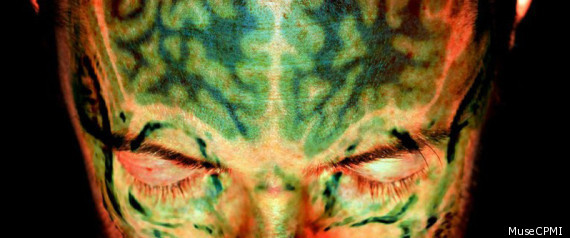
The exhibition "Seeing Ourselves: The Science and Art of Diagnostic Medical Imaging" shows that art and science are two means of making images. The collection features medical imaging modalities and contemporary artworks that, oftentimes, don't look all that different.
The show is curated by physicians Koan Jeff Baysa and Caitlin Hardy, who gathered work from 60 international artists all working in a variety of media. The works on display demonstrate the importance of sharing of institutional knowledge while also examining the advantages of viewing this information from an aesthetic standpoint.
Recent technology has brought on huge breakthroughs in medical imaging -- images of the human body created for clinical investigations. These advancements have enhanced our knowledge of our physical selves, but it also intensifies our view of ourselves.

The show will combine sculpture, painting, drawing and video with X-ray, MRI, PET, and CAT images. But don't let these abbreviations bore you; in the slideshow below, you'll see an image of the female orgasm as taken from TheVisualMD; it contains swirls of bright colors that look as artfully crafted as any painting.
This rare interdisciplinary exhibition features Suzanne Anker, Deborah Aschheim, Stephen Auger, Christophe Berdaguer and Marie Pejus with Christophe Laudamiel and Christoph Hornetz, Stefani Bardin and Toby Heys. It will show at MuseCPMI from March 10 through April 14.
Can you tell the science images from the art images? Test yourself below and let us know which images blew your mind!





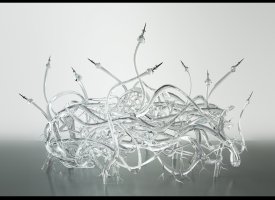
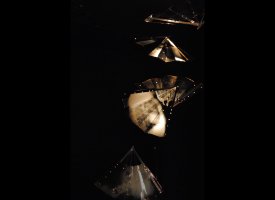
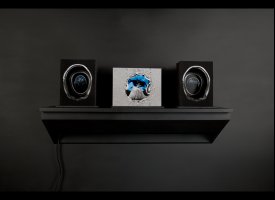

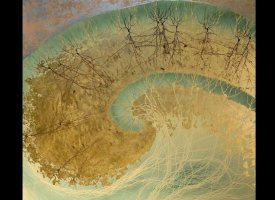

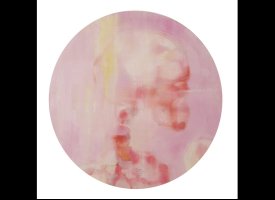
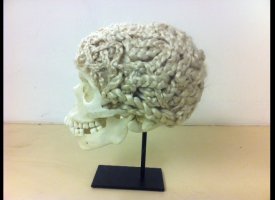
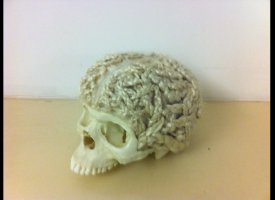
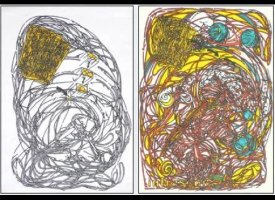
Tuesday, July 24, 2012
Monday, July 23, 2012
A Visit With Art-World Hero Chuck Close
Getting some face time, as he gears up for his new fall show
"Lou Reed's got wrinkles in his wrinkles."
Artist Chuck Close and I are in his ground-floor studio on Bond Street. He's describing a giant tapestry of Reed's face that he's hoping to have ready by mid October. The studio is jammed with assistants color-correcting dyes, poring over photographic images, and managing office business. It's an especially busy time for Team Close—the 72-year-old painter is preparing for his long-awaited fall show at Chelsea's Pace Gallery. Arrayed around the walls are some of his closest friends—Roy, Paul, Philip, Laurie, Cindy. In his relaxed company, it's practically immaterial that they're all celebrities. "I always wanted to make paintings of ordinary, undistinguished people," Close says as if reading my thoughts. "It's not my fault they became famous."
There's a certain kind of virtuosity that amplifies its achievements by a million trillion. Beethoven composed his Ninth Symphony while deaf. James Joyce wrote Finnegans Wake with a magnifying glass. Barack Obama became the 44th president of the United States while black.
For people who love art, young or old, with-it or fusty, Republican or Democrat, the painter Chuck Close has long formed part of this virtuosic pantheon. An artist celebrated like few people in or out of the art world, Close commands not just attention, but also bona fide affection. To see him at huge museum affairs, art-fair openings, or charitable events is to see Moses part waters thick with social climbing, calculation, and envy. His presence—like that of a civil rights leader or sports hero—is mollifying. As he once put it to me, "For the last 14 years, I've not gone a day where I go outside and don't have someone tell me how much they like what I do. I'm really very, very lucky." Never mind that Chuck Close is a partial quadriplegic and largely confined to a wheelchair.
To say that Chuck Close is handicapped is to miss an important part of his gift, if not to significantly misstate facts. A white tornado of activity that pulls together art, politics, education, and just plain socializing, Close has long had what Robert Hughes in 1998 called "a reputation as a stick-to-it, intensely focused, all-around good guy of the American art world." This reputation has gone mainstream in the past few years, as Close's constant civic-mindedness has resulted in his appointment to the President's Committee on the Arts and the Humanities, as well as his recruitment to mentor struggling schools for Turnaround Arts—a recent administration-led arts-education initiative that closely echoes the artist's own oft-quoted precepts.
I meet Close for pasta e vino at his favorite neighborhood restaurant, Il Buco, before our killer studio visit. It's a spot Close likes so much he treats it as both caviarteria and canteen. I want him to talk about his art, his life, his devotion to arts education, but also what compels him to be a "good art-world citizen." That phrase, which is his, speaks volumes about him. Not for the last time, though, he turns the subject back to children's learning.
"Some people say we need art in school because playing violin is good for your math skills," the National Medal of Arts winner tells me after the first glass of wine is poured. "But I believe it solves an even bigger problem than test scores, and that's the dropout rate. When I was in school, as learning disabled as I was, we had art and music several times a week. Had I not had that, I would have dropped out of school."
Arts education is a subject extremely dear to Chuck Close's heart. As an official portraitist, he recently got to bend Obama's ear on the subject as the president sat down for his Polaroid picture. "I photographed him last week for an hour and a half," Close relays, "and boy, did I take the opportunity to lobby him."
The memory of that conversation shifts quickly to a less friendly encounter with Mayor Bloomberg and former NYC schools chancellor Joel Klein. At a small dinner party—"10 or 12 people, no more"—Close shared his thinking about why the two powerful city politicians remained flummoxed by New York's high dropout rates.
"It's because you have such a narrow definition of what success is," he told them. "If you're not good at math and science, you're not a successful person." Close proceeded to illustrate his case with his own biography and to chastise the two for shifting funds from the arts to remedial education. Bloomberg's response was casually condescending: "Oh, Chuck, you would have been all right because you're a genius." Angered, Close shot back, "I suppose I should be flattered, but how would I know that I had any abilities if I'd had next to no exposure to art and music." (According to Close, the scrappy colloquy's final chapter came days later, when Klein rang to tell him that the city had restored "a couple of million dollars" to school arts funding.)
Charles Thomas Close was born severely dyslexic. "I still can't add or subtract in my head," he says, "and never learned my multiplication tables, which meant no algebra, geometry, physics, or chemistry." He knew nothing about the disorder until he attended a lecture on the subject with his eight-year-old daughter in the 1970s. Close also suffered from neuromuscular problems as a child. This meant, despite his height and build (he's six feet three inches), that he "couldn't run, couldn't throw a ball, and couldn't keep up with the other kids physically." Art gave Close a competitive edge—it offered him pure learning beyond the understanding of most adults. Close still grimaces when recalling the advice he got from educators: "My high school counselor told me that I would never get into college, but that I should consider body and fender school."
A Visit With Art-World Hero Chuck Close
Getting some face time, as he gears up for his new fall show
"Lou Reed's got wrinkles in his wrinkles."
Artist Chuck Close and I are in his ground-floor studio on Bond Street. He's describing a giant tapestry of Reed's face that he's hoping to have ready by mid October. The studio is jammed with assistants color-correcting dyes, poring over photographic images, and managing office business. It's an especially busy time for Team Close—the 72-year-old painter is preparing for his long-awaited fall show at Chelsea's Pace Gallery. Arrayed around the walls are some of his closest friends—Roy, Paul, Philip, Laurie, Cindy. In his relaxed company, it's practically immaterial that they're all celebrities. "I always wanted to make paintings of ordinary, undistinguished people," Close says as if reading my thoughts. "It's not my fault they became famous."
There's a certain kind of virtuosity that amplifies its achievements by a million trillion. Beethoven composed his Ninth Symphony while deaf. James Joyce wrote Finnegans Wake with a magnifying glass. Barack Obama became the 44th president of the United States while black.
For people who love art, young or old, with-it or fusty, Republican or Democrat, the painter Chuck Close has long formed part of this virtuosic pantheon. An artist celebrated like few people in or out of the art world, Close commands not just attention, but also bona fide affection. To see him at huge museum affairs, art-fair openings, or charitable events is to see Moses part waters thick with social climbing, calculation, and envy. His presence—like that of a civil rights leader or sports hero—is mollifying. As he once put it to me, "For the last 14 years, I've not gone a day where I go outside and don't have someone tell me how much they like what I do. I'm really very, very lucky." Never mind that Chuck Close is a partial quadriplegic and largely confined to a wheelchair.
To say that Chuck Close is handicapped is to miss an important part of his gift, if not to significantly misstate facts. A white tornado of activity that pulls together art, politics, education, and just plain socializing, Close has long had what Robert Hughes in 1998 called "a reputation as a stick-to-it, intensely focused, all-around good guy of the American art world." This reputation has gone mainstream in the past few years, as Close's constant civic-mindedness has resulted in his appointment to the President's Committee on the Arts and the Humanities, as well as his recruitment to mentor struggling schools for Turnaround Arts—a recent administration-led arts-education initiative that closely echoes the artist's own oft-quoted precepts.
I meet Close for pasta e vino at his favorite neighborhood restaurant, Il Buco, before our killer studio visit. It's a spot Close likes so much he treats it as both caviarteria and canteen. I want him to talk about his art, his life, his devotion to arts education, but also what compels him to be a "good art-world citizen." That phrase, which is his, speaks volumes about him. Not for the last time, though, he turns the subject back to children's learning.
"Some people say we need art in school because playing violin is good for your math skills," the National Medal of Arts winner tells me after the first glass of wine is poured. "But I believe it solves an even bigger problem than test scores, and that's the dropout rate. When I was in school, as learning disabled as I was, we had art and music several times a week. Had I not had that, I would have dropped out of school."
Arts education is a subject extremely dear to Chuck Close's heart. As an official portraitist, he recently got to bend Obama's ear on the subject as the president sat down for his Polaroid picture. "I photographed him last week for an hour and a half," Close relays, "and boy, did I take the opportunity to lobby him."
The memory of that conversation shifts quickly to a less friendly encounter with Mayor Bloomberg and former NYC schools chancellor Joel Klein. At a small dinner party—"10 or 12 people, no more"—Close shared his thinking about why the two powerful city politicians remained flummoxed by New York's high dropout rates.
"It's because you have such a narrow definition of what success is," he told them. "If you're not good at math and science, you're not a successful person." Close proceeded to illustrate his case with his own biography and to chastise the two for shifting funds from the arts to remedial education. Bloomberg's response was casually condescending: "Oh, Chuck, you would have been all right because you're a genius." Angered, Close shot back, "I suppose I should be flattered, but how would I know that I had any abilities if I'd had next to no exposure to art and music." (According to Close, the scrappy colloquy's final chapter came days later, when Klein rang to tell him that the city had restored "a couple of million dollars" to school arts funding.)
Charles Thomas Close was born severely dyslexic. "I still can't add or subtract in my head," he says, "and never learned my multiplication tables, which meant no algebra, geometry, physics, or chemistry." He knew nothing about the disorder until he attended a lecture on the subject with his eight-year-old daughter in the 1970s. Close also suffered from neuromuscular problems as a child. This meant, despite his height and build (he's six feet three inches), that he "couldn't run, couldn't throw a ball, and couldn't keep up with the other kids physically." Art gave Close a competitive edge—it offered him pure learning beyond the understanding of most adults. Close still grimaces when recalling the advice he got from educators: "My high school counselor told me that I would never get into college, but that I should consider body and fender school."
Saturday, July 21, 2012
A European Art Darling Makes Her Solo Debut in New York

A European Art Darling Makes Her Solo Debut in New York

Will You Watch (and Love to Hate) Gallery Girls? “The art world is super cutthroat”
Oh, reality TV! You’re such a guilty pleasure for so many. And I’ll admit, from time to time, I’m drawn into your scripted “real-life” drama (and I LOVE every minute of it…even when I’m ridiculously shreiking at the TV: “No! NOOOO! You have to send So&So home or I swear to sh*t, I’m not watching next week!…So, have they shown next week’s preview yet?!!”).
And now we have Gallery Girls.
Bravo’s Gallery Girls is a docu-series that follows the lives of seven dynamic and ambitious young women in New York City who tackle the cutthroat environment of the art world while vying for their dream jobs. From gallery openings and art shows to the hottest events in the city, the women share a passion for art — but are divided between their Manhattan and Brooklyn lifestyles with vastly different views and tastes towards fashion, art, and men. Attempting to juggle a chic and fabulous standard of living, the ladies tackle financial struggles, family issues, and the pressures of jump starting their lives in the city that never sleeps. [Bravo TV]

“Girls! Girls! Girls!” – BravoTV.com
I mean, look at the pic to the side. It already makes me scream, “Look at these bitches! You know they’re gonna start some SHIIIIT!” …Isn’t that terrible of me? ;P
I tried to take a look at the preview, but the video wasn’t working. From what I can tell though, this might be more like The Hills and shows of that sort. I’ve never dipped my TV-loving-toes into that particular pool of reality shows, and I fear what might happen if I begin with one that’s supposedly representing the world of art (will viewers really think it does? …Some will, won’t they?).
For anyone who doesn’t identify with the Gallery Girls‘ conception of the art world, this will be the show you love to hate. But this isn’t really a show about art anyway; Gallery Girls is as much about art as Survivor is about tropical ecology. This is a show about the swirl of capital and ego that surrounds and occasionally attaches itself to art. “Art” just serves as the excuse — the mover of dollars, a tool of self-glorification and an occasion for parties. [Hyperallergic]
The first season includes Liz Margulies, Kerri Lisa, Chantal Chadwick, Claudia Martinez , Angela Pham, Amy Poliakoff, and Maggie Schaffer. Mostly white. All typically pretty. All appear as if they could be within a few years in age of each other. Pretty much what you’d expect (which is unfortunate).
The series premieres on August 13th on Bravo, but that doesn’t necessarily mean we’ll be seeing it here in Canada at the same time, so I’ll be sure to keep and eye open.
What are your thoughts? Will you watch (and love to hate) Gallery Girls?
Will You Watch (and Love to Hate) Gallery Girls? “The art world is super cutthroat”
Oh, reality TV! You’re such a guilty pleasure for so many. And I’ll admit, from time to time, I’m drawn into your scripted “real-life” drama (and I LOVE every minute of it…even when I’m ridiculously shreiking at the TV: “No! NOOOO! You have to send So&So home or I swear to sh*t, I’m not watching next week!…So, have they shown next week’s preview yet?!!”).
And now we have Gallery Girls.
Bravo’s Gallery Girls is a docu-series that follows the lives of seven dynamic and ambitious young women in New York City who tackle the cutthroat environment of the art world while vying for their dream jobs. From gallery openings and art shows to the hottest events in the city, the women share a passion for art — but are divided between their Manhattan and Brooklyn lifestyles with vastly different views and tastes towards fashion, art, and men. Attempting to juggle a chic and fabulous standard of living, the ladies tackle financial struggles, family issues, and the pressures of jump starting their lives in the city that never sleeps. [Bravo TV]

“Girls! Girls! Girls!” – BravoTV.com
I mean, look at the pic to the side. It already makes me scream, “Look at these bitches! You know they’re gonna start some SHIIIIT!” …Isn’t that terrible of me? ;P
I tried to take a look at the preview, but the video wasn’t working. From what I can tell though, this might be more like The Hills and shows of that sort. I’ve never dipped my TV-loving-toes into that particular pool of reality shows, and I fear what might happen if I begin with one that’s supposedly representing the world of art (will viewers really think it does? …Some will, won’t they?).
For anyone who doesn’t identify with the Gallery Girls‘ conception of the art world, this will be the show you love to hate. But this isn’t really a show about art anyway; Gallery Girls is as much about art as Survivor is about tropical ecology. This is a show about the swirl of capital and ego that surrounds and occasionally attaches itself to art. “Art” just serves as the excuse — the mover of dollars, a tool of self-glorification and an occasion for parties. [Hyperallergic]
The first season includes Liz Margulies, Kerri Lisa, Chantal Chadwick, Claudia Martinez , Angela Pham, Amy Poliakoff, and Maggie Schaffer. Mostly white. All typically pretty. All appear as if they could be within a few years in age of each other. Pretty much what you’d expect (which is unfortunate).
The series premieres on August 13th on Bravo, but that doesn’t necessarily mean we’ll be seeing it here in Canada at the same time, so I’ll be sure to keep and eye open.
What are your thoughts? Will you watch (and love to hate) Gallery Girls?





















